
Difference between revisions of "Plants for swales"
m |
m |
||
| Line 60: | Line 60: | ||
'''Zone 5 (Upland zone)''' – The upland zone is seldom or never inundated. A wide variety of species are well adapted to the upland zone and their selection will depend on the site conditions. | '''Zone 5 (Upland zone)''' – The upland zone is seldom or never inundated. A wide variety of species are well adapted to the upland zone and their selection will depend on the site conditions. | ||
| − | [[File:Marsh marigold.png| | + | [[File:Marsh marigold.png|500px|thumb|left|alt=photo sedge|<font size=3>Marsh marigold, Zone 2. From [https://www.pca.state.mn.us/sites/default/files/pfsd-section1.pdf Shaw and Schmidt] (2003).</font size>]] |
{| class="wikitable" style="float:right; margin-left: 10px; width:1000px;" | {| class="wikitable" style="float:right; margin-left: 10px; width:1000px;" | ||
| Line 143: | Line 143: | ||
|} | |} | ||
| − | [[File:river bulrush.png| | + | [[File:river bulrush.png|500px|thumb|left|alt=photo sedge|<font size=3>River bulrush sedge, Zones 2 and 3. From [https://www.pca.state.mn.us/sites/default/files/pfsd-section1.pdf Shaw and Schmidt] (2003).</font size>]] |
| − | [[File:Awl fruited sedge.png| | + | [[File:Awl fruited sedge.png|500px|thumb|left|alt=photo sedge|<font size=3>Awl-fruited sedge, Zone 3. From [https://www.pca.state.mn.us/sites/default/files/pfsd-section1.pdf Shaw and Schmidt] (2003).</font size>]] |
| − | [[File:Culvers root.png| | + | [[File:Culvers root.png|500px|thumb|left|alt=photo sedge|<font size=3>Culver's root, Zone 3. From [https://www.pca.state.mn.us/sites/default/files/pfsd-section1.pdf Shaw and Schmidt] (2003).</font size>]] |
| − | [[File:Canada anemone.png| | + | [[File:Canada anemone.png|500px|thumb|left|alt=photo sedge|<font size=3>Canada anemone, Zone 4. From [https://www.pca.state.mn.us/sites/default/files/pfsd-section1.pdf Shaw and Schmidt] (2003).</font size>]] |
{| class="wikitable" style="float:right; margin-left: 10px; width:1000px;" | {| class="wikitable" style="float:right; margin-left: 10px; width:1000px;" | ||
Revision as of 13:29, 26 March 2018
| Zone 2 - Emergent zone (0 - 18 inches of water) | |
| Scientific name | Common name |
| Forbs and ferns | |
| Acorus calamus | Sweet flag |
| Alisma trivale | Water plantain |
| Caltha palustris | Marsh marigold |
| Polygonum amphibium | Water smartweed |
| Pontederia cordata | Pickerelweed |
| Sagittaria latifolia | Broadleaved arrowhead |
| Sparganium eurycarpum | Giant burreed |
| Grasses, sedges, and rushes | |
| Carex aquatilis | Water sedge |
| Carex lacustris | Lake sedge |
| Carex stricta | Tussock sedge |
| Juncus balticus | Baltic rush |
| Juncus effusus | Soft rush |
| Scirpus acutus | Hardstem bulrush |
| Scirpus Fluviatilis | River bulrush |
| Scirpus pungens | Three-square bulrush |
| Scirpus validus | Soft-stem bulrush |
The tables and content on this page have been adapted from [“Plants for Stormwater Design: Species Selection for the Upper Midwest” (Daniel Shaw and Rusty Schmidt, Minnesota Pollution Control Agency, 2003). To obtain a free copy of this guidebook, telephone (651) 297-8679 or write to Operations and Environmental Review Section, Regional Environmental Management Division, Minnesota Pollution Control Agency, 520 Lafayette Rd. N., Saint Paul, MN 55103-1402.
- Zone 1: Submergent zone; 1.5 to 6 feet of water
- Zone 2: Emergent zone; 0 to 18 inches of water
- Zone 3: Wet meadow zone; permanent moistue
- Zone 4: Floodplain zone; flooded during snowmelt and large storms
- Zone 5:Upland zone; seldom or never inundated (the upland zone includes prairie and forest plant communities)
Zone 1 (Submergent zone) – The submergent zone is found in areas of 3-6 feet of water in wet ponds. Therefore, it is an unlikely zone to include in a Swale design, though exceptions may occur. Submergent vegetation makes up this zone because emergent vegetation generally does not grow deeper than 3 feet. Submergent species may float free in the water column or may root in the pool bottom and have stems and leaves that generally stay under water. Submergent species are important for wildlife habitat and pollutant removal, especially nitrates and phosphorus. Submergent species are not readily available from native plant nurseries and can be difficult to plant. Many submergent species establish on their own (Ogle and Hoag 2000).
Zone 2 (Emergent zone) – The emergent zone of a wet pond is generally 0 to 18 inches deep. It is often designed as benches within ponds to optimize the area for emergent plants. This zone is most common to Swale designs from the center of the Swale to, typically, the water quality stage elevation. Emergent plants are important for wildlife and evapotranspiration. They also provide habitat for phytoplankton, which play an important role in nutrient removal (Ogle and Hoag 2000). A wide variety of wetland species are adapted to the emergent zone. However, large fluctuations in water level and pollutants within wet ponds may limit the number of species.
Zone 3 (Wet meadow zone) – The wet meadow zone is a constantly moist area that can become inundated. The transition area between open water and the shoreline is prone to erosion. Therefore, it is an important area for plant establishment. This zone extends from Zone 2 to the Zone 4 and is common in swale designs. In addition to wet-meadow grasses, sedges, flowers and shrubs, such as dogwoods, willows, buttonbush and chokeberry, are well suited to this zone.
Zone 4 (Floodplain zone) – The floodplain zone is normally dry but may flood during snowmelt and after large storms. This zone can occur in Swales designed with 2-stages of inundation; one for water quality storage and the second for channel protection storage. It should be noted that small depression storage can be built into this zone as wetland storage areas for additional treatment and habitat enhancement. These depressions would be considered either Zone 1-3, depending on depth and duration of inundation. Floodplain zones are generally flat terraces and are common along rivers and streams. If a wet pond has a steep side slope, it may go directly from zone 3 (wet meadow zone) to zone 5 (upland zone) without having a floodplain zone. Floodplain species must be adapted to extremes in hydrology; they may be inundated for long periods in the spring and be dry during the summer. The ability of floodplain species to handle extremes in hydrology make them well suited to the edges of wet ponds and detention ponds.
Zone 5 (Upland zone) – The upland zone is seldom or never inundated. A wide variety of species are well adapted to the upland zone and their selection will depend on the site conditions.
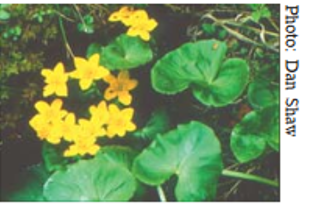
| Zone 3 - Wet meadow zone; permanent moisture | |
| Scientific name | Common name |
| Trees and shrubs | |
| Amorpha fruticosa | Indigo bush |
| Salex nigra | Black willow |
| Sambucus pubens | Red-berried elder |
| Forbs and ferns | |
| Thalictrum dasycarpum | Tall meadowrue |
| Verbena hastata | Blue vervain |
| Vernonia fasciculata | Ironweed |
| Veronicastrum virginicum | Culver's root |
| Grasses, sedges, and rushes | |
| Andropogon gerardii | Big bluestem |
| Bromus ciliatus | Fringed brome |
| Calamagrostis canadensis | Canada blue-joint grass |
| Carex bebbii | Bebb's sedge |
| Carex comosa | Bottlebrush sedge |
| Carex crinita | Caterpillar sedge |
| Carex hystericina | Porcupine sedge |
| Carex languinosa | Wooly sedge |
| Carex lasiocarpa | Wooly needle sedge |
| Carex retrorsa | Retrorse sedge |
| Carex stipata | Awl-fruited sedge |
| Carex vulpinoidea | Fox sedge |
| Eleocharis obtusa | Blunt spikerush |
| Equisetum fluviatile | Horsetail |
| Glyceria grandis | Giant manna grass |
| Glyceria striata | Fowl manna grass |
| Juncus balticus | Baltic rush |
| Juncus effusus | Soft rush |
| Juncus torreyi | Torrey rush |
| Leersia oryzoides | Rice-cut grass |
| Panicum virgatum | Switchgrass |
| Scirpus atrovirens | Green bulrush |
| Scirpus cyperinus | Woolgrass |
| Scirpus fluviatilis | River bulrush |
| Scirpus pungens | Three-square bulrush |
| Scirpus validus | Soft-stem bulrush |
| Spartina pectinata | Prairie cord grass |
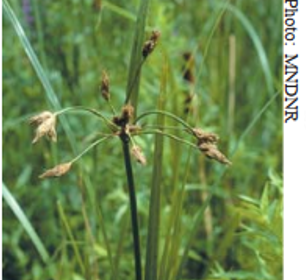
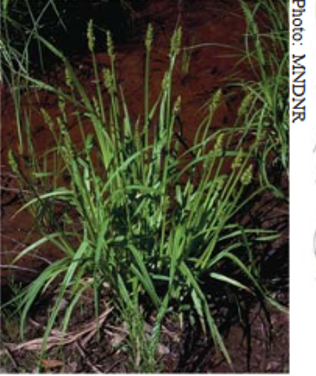
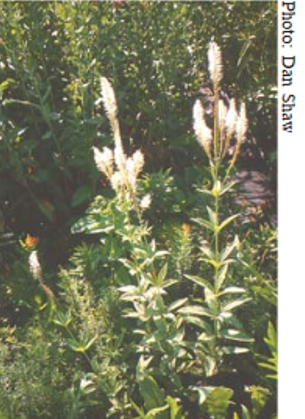
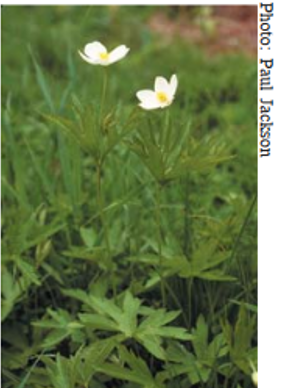
| Zone 4 - Floodplain zone; flooded during snowmelt and large storms | |
| Scientific name | Common name |
| Trees and shrubs | |
| Acer saccharinum | Silver maple |
| Alnus incana | Speckled alder |
| Amorpha fruticosa | Indigo bush |
| Aronia melanocarpa | Black chokecherry |
| Betula nigra | River birch |
| Celtis occidentalis | Hackberry |
| Cephalanthus occidentalis | Buttonbush |
| Cornus amomum | Silky dogwood |
| Cornus sericea | Red-osier dogwood |
| Fraxinus nigra | Black ash |
| Fraxinus pennsylvanica | Green ash |
| Physocarpus opulifolius | Ninebark |
| Populus deltoides | Eastern cottonwood |
| Quercus bicolor | Swamp white oak |
| Salix discolor | Pussy willow |
| Salix exigua | Sandbar willow |
| Salix nigra | Black willow |
| Sambucus pubens | Red-berried elder |
| Spiraea alba | Meadowsweet |
| Viburnum lentago | Nannyberry |
| Viburnum trilobum | High bush cranberry |
| Forbs and ferns | |
| Anemone canadensis | Canada anemone |
| Aster lucidulus | Swamp aster |
| Aster puniceus | Red-stemmed aster |
| Boltonia asteroides | Boltonia |
| Impatiens capensis | Jewelweed |
| Lobelia cardinalis | Cardinal flower |
| Lobelia siphilitica | Blue lobelia |
| Lysimachia thrysiflora | Tufted loosestrife |
| Physostegia virginiana | Obedient plant |
| Potentilla palustris | Marsh cinquefoil |
| Scutterlaria lateriflora | Mad-dog skullcap |
| Silphium perfoliatum | Cup plant |
| Symplocarpus foetidus | Skunk cabbage |
| Vernonia fasciculata | Ironweed |
| Grasses, sedges, and rushes | |
| Carex comosa | Bottlebrush sedge |
| Elymus virginicus | Virginia wild rye |
| Leersia oryzoides | Rice-cut grass |
| Panicum virgatum | Switchgrass |
| Scirpus atrovirens | Green bulrush |
| Spartina pectinata | Prairie cord grass |
| Zone 5 - Upland zone; seldom or never inundated | |
| Scientific name | Common name |
| Trees and shrubs | |
| Cornus racemosa | Gray dogwood |
| Populus tremuloides | Quaking aspen |
| Quercus bicolor | Swamp white oak |
| Viburnum lentago | Nannyberry |
| Viburnum trilobum | High bush cranberry |
| Forbs and ferns | |
| Agastache foeniculum | Giant hyssop |
| Allium stellatum | Prairie wild onion |
| Arisaema triphyllum | Jack-in-the-pulpit |
| Artemisia ludoviciana | Prairie sage |
| Asclepias tuberosa | Butterfly milkweed |
| Aster laevis | Smooth aster |
| Aster lanceolatus (simplex) | Pacicled aster |
| Aster macrophyllus | Bigleaf aster |
| Aster pilosus | Frost aster |
| Athyrium filix-femina | Lady fern |
| Boltonia asteroides | Boltonia |
| Epilobium angustifolium | Fireweed |
| Galium boreale | Northern bedstraw |
| Helianthus grosseserratus | Sawtooth sunflower |
| Heuchera richardsonii | Prairie alumroot |
| Monarda fistulosa | Wild bergamot |
| Onoclea sensibilis | Sensitive fern |
| Potentilla palustris | Marsh cinquefoil |
| Pteridium aquilinum | Bracken fern |
| Pycnanthemum virginianum | Mountain mint |
| Ratibida pinnata | Yellow coneflower |
| Rudbeckia subtomentosa | Brown-eyed susan |
| Smilacina racemosa | False Solomon's seal |
| Solidago flexicaulis | Zig-zag goldenrod |
| Solidago riddellii | Riddell's goldenrod |
| Solidago rigida | Stiff goldenrod |
| Tradescantia ohiensis | Ohio spiderwort |
| Veronicastrum virginicum | Culver's root |
| Grasses, sedges, and rushes | |
| Andropogon gerardii | Big bluestem |
| Panicum virgatum | Switchgrass |
| Schizachyrium scoparium | Little bluestem |
| Sorghastrum nutans | Indian grass |
| Select dry swale-appropriate plants | |
| Scientific name | Common name |
| Forbs and ferns | |
| Anemone canadensis | Canada anemone |
| Artemisia ludoviciana | Prairie sage |
| Asclepias incarnata | Marsh milkweed |
| Aster puniceus | Red-stemmed aster |
| Euthanmia graminifolia | Flat-top goldenrod |
| Lobelia siphilitica | Blue lobelia |
| Pycnanthemum virginianum | Mountain mint |
| Verbena hastata | Blue vervain |
| Grasses, sedges, and rushes | |
| Andropogon gerardii | Big bluestem |
| Bromus ciliatus | Fringed brome |
| Calamagrostis canadensis | Canada blue-joint grass |
| Carex bebbii | Bebb's sedge |
| Carex vulpinoidea | Fox sedge |
| Elymus virginicus | Virginia wild rye |
| Glyceria striata | Fowl manna grass |
| Juncus effusus | Soft rush |
| Panicum virgatum | Switchgrass |
| Scirpus atrovirens | Green bulrush |
| Spartina pectinata | Prairie cord grass |
| Useful sod-forming grasses | |
| Agrostis palustris | Creeping bentgrass |
| Elymus sp. | Wheat-grass |
| Poa palustris | Fowl bluegrass |
| Select wet swale-appropriate plants | |
| Scientific name | Common name |
| Trees and shrubs | |
| Alnus incana | Speckled alder |
| Amorpha fruticosa | Indigo bush |
| Aronia melanocarpa | Black chokecherry |
| Betula nigra | River birch |
| Cephalanthus occidentalis | Buttonbush |
| Cornus amomum | Silky dogwood |
| Cornus racemosa | Gray dogwood |
| Cornus sericea | Red-osier dogwood |
| Ilex verticillata | Winterberry |
| Larix laricina | Tamarck |
| Physocarpus opulifolius | Ninebark |
| Salix discolor | Pussy willow |
| Salix exigua | Sandbar willow |
| Sambucus pubens | Red-berried elder |
| Spiraea alba | Meadowsweet |
| Viburnum lentago | Nannyberry |
| Viburnum trilobum | High bush cranberry |
| Forbs and ferns | |
| Agastache foeniculum | Giant hyssop |
| Alisma trivale | Water plantain |
| Anemone canadensis | Canada anemone |
| Angelica atropurpurea | Angelica |
| Artemisia ludoviciana | Prairie sage |
| Asclepias incarnata | Marsh milkweed |
| Aster lanceolatus (simplex) | Panicle aster |
| Aster lucidulus | Swamp aster |
| Aster novae-angliae | New England aster |
| Aster puniceus | Red-stemmed aster |
| Boltonia asteroides | Boltonia |
| Caltha palustris | Marsh marigold |
| Chelone glabra | Turtlehead |
| Equisetum fluviatile | Horsetail |
| Eryngium yuccifolium | Rattlesnake master |
| Eupatorium maculatum | Joe-pye-weed |
| Eupatorium perfoliatum | Bonset |
| Euthanmia graminifolia | Grass-leaved goldenrod |
| Gentiana andrewsii | Bottle gentian |
| Helenium autumnale | Sneezeweed |
| Helianthus grosseserratus | Sawtooth sunflower |
| Impatiens capensis | Jewelweed |
| Iris versicolor | Blueflag |
| Liatris ligulistylis | Meadow blazingstar |
| Liatris pychnostachya | Prairie blazingstar |
| Lilium superbum | Turks-cap lily |
| Lobelia cardinalis | Cardinal flower |
| Lobelia siphilitica | Blue lobelia |
| Lysimachia thrysiflora | Tufted loosestrife |
| Monarda fistulosa | Wild bergamot |
| Onoclea sensibilis | Sensitive fern |
| Osmunda regalis | Royal fern |
| Physostegia virginiana | Obedient plant |
| Polygonum amphibium | Water smartweed |
| Pontederia cordata | Pickerelweed |
| Potentilla palustris | Marsh cinquefoil |
| Pycnanthemum virginianum | Mountain mint |
| Rudbeckia subtomentosa | Brown-eyed Susan |
| Sagittaria latifolia | Broadleaved arrowhead |
| Scutterlaria lateriflora | Mad-dog skullcap |
| Silphium perfoliatum | Cup plant |
| Solidago rigida | Stiff goldenrod |
| Sparganium eurycarpum | Giant burreed |
| Symplocarpus foetidus | Skunk cabbage |
| Thalictrum dasycarpum | Tall meadowrue |
| Tradescantia ohiensis | Ohio spiderwort |
| Verbena hastata | Blue vervain |
| Vernonia fasciculata | Ironweed |
| Veronicastrum virginicum | Culver's root |
| Zizia aurea | Golden alexanders |
| Grasses, sedges, and rushes | |
| Andropogon gerardii | Big bluestem |
| Bromus ciliatus | Fringed brome |
| Calamagrostis canadensis | Canada blue-joint grass |
| Carex aquatilis | Water sedge |
| Bebb's sedge | |
| Carex comosa | Bottlebrush sedge |
| Carex crinita | Caterpillar sedge |
| Carex hystericina | Porcupine sedge |
| Carex lacustris | Lake sedge |
| Carex languinosa | Wooly sedge |
| Carex lasiocarpa | Wooly needle sedge |
| Carex retrorsa | Retrorse sedge |
| Carex stipata | Awl-fruited sedge |
| Carex stricta | Tussock sedge |
| Carex vulpinoidea | Fox sedge |
| Eleocharis obtusa | Blunt spikerush |
| Elymus virginicus | Virginia wild rye |
| Glyceria grandis | Giant manna grass |
| Glyceria striata | Fowl manna grass |
| Juncus balticus | Baltic rush |
| Juncus effusus | Soft rush |
| Juncus torreyi | Torrey rush |
| Leersia oryzoides | Rice-cut grass |
| Panicum virgatum | Switchgrass |
| Scirpus acutus | Hardstem bulrush |
| Scirpus atrovirens | Green bulrush |
| Scirpus cyperinus | Woolgrass |
| Scirpus fluviatilis | River bulrush |
| Scirpus pungens | Three-square bulrush |
| Scirpus validus | Soft-stem bulrush |
| Spartina pectinata | Prairie cord grass |
| Typha latifolia | Broadleaved cattail |